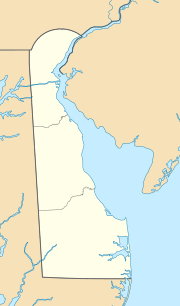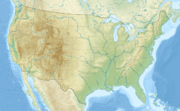Agricultural Ditch (Dirickson Creek tributary) facts for kids
Quick facts for kids Agricultural Ditch |
|
|---|---|
| Other name(s) | Tributary to Dirickson Creek |
| Country | United States |
| State | Delaware |
| County | Sussex |
| Physical characteristics | |
| Main source | McCray Branch divide about 0.25 miles northwest of Roxana, Delaware 30 ft (9.1 m) 38°30′37″N 075°10′39″W / 38.51028°N 75.17750°W |
| River mouth | Dirickson Creek about 0.25 miles north of Fenwick West, Delaware 0 ft (0 m) 38°29′32″N 075°07′44″W / 38.49222°N 75.12889°W |
| Length | 3.93 mi (6.32 km) |
| Basin features | |
| Progression | generally southeast |
| River system | Little Assawoman Bay |
| Basin size | 2.61 square miles (6.8 km2) |
| Tributaries |
|
| Bridges | DE 20 Bennett Road DE 17 DE 370 Bayard Road Old Mill Bridge Road |
Agricultural Ditch is a small waterway, about 3.93 mi (6.32 km) long, located in Sussex County, Delaware. It's like a smaller stream that flows into a bigger one, which in this case is Dirickson Creek. When we say it's a "2nd order tributary," it means it's a stream that forms when two smaller, "1st order" streams join together.
What's in a Name?
Sometimes, waterways have more than one name! Historically, Agricultural Ditch has also been known as:
- Carey Branch
Where Does It Start and Go?
Agricultural Ditch begins its journey near a place called Roxana in Sussex County, Delaware. It starts close to the McCray Branch divide, which is like a natural boundary separating different water flow areas.
From there, Agricultural Ditch flows generally towards the southeast. It continues its path until it meets and joins Dirickson Creek. This meeting point is about 0.25 miles north of Fenwick West, Delaware.
The Water's Home: Its Watershed
Every stream and river has a special area of land called a watershed. This is the area where all the rain and snowmelt drain into that particular stream. The watershed for Agricultural Ditch covers about 2.61 square miles (6.8 km2) of land.
This area gets a good amount of rain each year, about 44.7 inches. A small part of the watershed, about 7.3%, is covered by forests.



